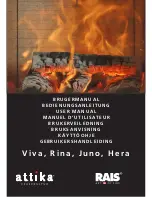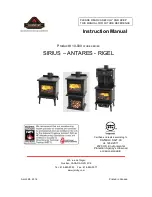
5
distance of incorporated parts made of combustible materials from charging opening to
lateral sides must be minimum 80 cm.
Safety clearance to objects that should be protected (combustible walls, walls containing
combustible building blocks, kitchen closets and steel concrete bearing walls) should be
no less than 20 cm,
and 30 cm laterally
.
Sufficient clearance should be ensured around the cook-stove in relation to combustible
objects (objects with wooden sheathing, furniture, curtains and like).
When cook-stove steel plate is used, superstructures above the cook-stove are not
allowed.
If pipes for exhaust gases are moved, minimum clearance of
40 cm
to combustible
materials should be observed:
Before the cook-stove is connected to chimney, chimney-sweeper in charge for that
area must be consulted.
Cook-stove shall be connected to the chimney with the use of appropriate connecting
components according to JUS.M.R4.031 (DIN 1298. or DIN EN 1856-2).
Care should be taken that socket for connection to the chimney and chimney flue does
not enter the cross-section of the chimney exhaust gas pipe and to be mutually sealed.
DIN 18 160 has to be generally observed.
For chimney gauges EN 13 384 applies
.
In order to achieve desired capacity, your cook-stove must be properly installed and first
and foremost chimney has to function flawlessly.
In any case, existing chimney pressure should be tested before putting the cook-stove into
operation.
The simplest method of chimney draught control is to hold lighted candle under the
chimney opening. The draught is sufficient if candle flame bends towards the chimney
opening.
Slight bending of candle flame means that the draught is weak.
If two firing facilities are installed on one floor and one masonry chimney (multiple
loads), the distance between the connections can be no less than 50 cm.






























